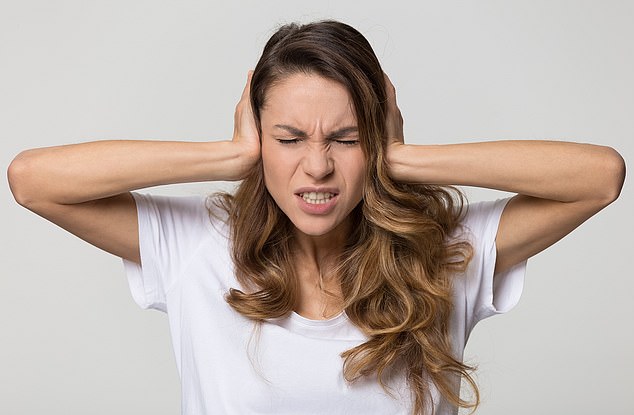
If you’re ever angered by the sound of coughing, repetitive tapping or a rustling crisp packet, you may have misophonia – a strong dislike or hatred of certain sounds.
Scientists say 20 per cent of people suffer from the condition to varying degrees, with less than one per cent of people experiencing the most extreme symptoms.
Some may dismiss misophonia as trivial, but the little-understood condition can lead to anxiety and depression, aggression and even acts of physical violence.
To help you see if you’re one of those affected, MailOnline has created an interactive test that asks a short series of questions with multiple choice answers.
The test estimates whether or not you have the condition and, if you do, whether it ranges from ‘mild’ to ‘extreme’.
SCROLL DOWN TO TAKE THE INTERACTIVE TEST


Misophonia, which means literally ‘hatred of sound’, is a condition in which sufferers experience intense and involuntary reactions to certain sounds made by other people
MailOnline’s test is based on the Amsterdam Misophonia Scale (A-MISO-S), a tool developed by researchers in the Dutch capital in 2013.
The test consists of just six questions with multiple choice answers that allocate points between zero to four.
At the end of the test, it adds up your points tally to determine whether you have misophonia – and if your symptoms are ‘mild’, ‘moderate’, ‘severe’ or ‘extreme’.
Readers should bear in mind, however, that it is not a clinical diagnosis, which is done by professionals through clinical interviews and questionnaires.
Misophonia – which literally means ‘hatred of sound’ – causes sufferers to experience intense and involuntary reactions to certain sounds made by other people, referred to as ‘triggers’.
Trigger sounds can be the sound of someone chewing, breathing or speaking and is usually related to mouth, throat or facial activity.
But other examples are the clicking of a pen, the tapping of a foot, clocks ticking, shoes scuffing the ground and a refrigerator humming.
In extreme cases, misophonia will cause intense anger and provoke the desire to react aggressively, possibly posing a danger to people in the vicinity.
These responses also lead to feelings of guilt in those affected, sometimes leading to anxiety and depression.


Concept image shows the causes of misophonia, which refers to getting annoyed by noises other people make, rather than actions. Note that misokinesia, or a ‘hatred of movements’, is a different condition
Those with the more severe forms can find themselves unable to tolerate family, work, public or social situations.
According to the University of Sussex, misophonia is little-understood compared with other conditions, including why some people are more vulnerable to developing the condition than others.
The university has a team of psychologists dedicated to promoting ‘a clear scientific understanding of misophonia’, especially in children and young people.
It follows a study published earlier in the week that one in five of the UK population suffer from misophonia to some degree.
The researchers surveyed more than 700 Britons – most of whom hadn’t heard of the term ‘misophonia’ before.
The survey asked about common ‘trigger sounds’ and asked respondents to describe their emotional response and its intensity using a 10-point scale.
In all, 18 per cent appeared to have significant symptoms of misophonia, while the most common negative reaction to triggers was irritation.
Some of the individuals with misophonia reported that they felt trapped or helpless when they could not get away from these sounds.


For people with misophonia, trigger sounds can range from someone breathing to the tapping of a pen (file photo)
‘The experience of misophonia is more than just being annoyed by a sound,’ said senior study author Dr Jane Gregory at the University of Oxford.
‘Misophonia can cause feelings of helplessness and being trapped when people can’t get away from an unpleasant sound.’
‘Often those with misophonia feel bad about themselves for reacting the way they do, especially when they are responding to sounds made by loved ones.’
Misophonia differs from misokinesia – a similar psychological response to the sight of someone else’s small but repetitive movements.
A Canadian team of researchers reported in 2021 that misokinesia affects around around one in three people.
This post first appeared on Dailymail.co.uk










